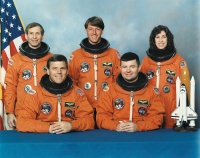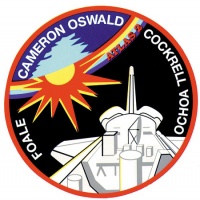STS-56
From The Space Library
 | |
| Organization | NASA-Office of Space Flight (United States) |
|---|---|
| Mission type | Earth Science,Human Crew,Life Science |
| Launch date | April 8, 1993 |
| Launch vehicle | Space Shuttle |
| Launch site | Cape Canaveral, United States |
| COSPAR ID | 1993-023A |
| Inclination | 57 degrees |
| Experiments | Here |
| Alternate Names | 22621 |
| Additional Information | Here |
| PDMP Information | Here |
| Telecommunications Information | Here |
| Data Collection | Here |
| Payload Mass Up | 7441 kg |
| Payload Mass Down | 7457.27 kg |
| Orbiter | Discovery |
| Lift Off Mass | 2,045,825.00 kg |
| Orbiter Weight at Liftoff | 107,572.27 kg |
| Orbiter Weight at Landing | 94,025.00 kg |
| Landed | Concrete runway 33 at Kennedy Space Center, Fla. |
| Orbits of Earth | 148 |
| Orbital Altitude | 160 nautical miles (184 statute miles) |
Contents |
[edit] Crew
- Commander: Kenneth Cameron
- Pilot: Stephen S. Oswald
- Payload Commander:
- Mission Specialist 1: Michael Foale
- Mission Specialist 2: Kenneth D. Cockrell
- Mission Specialist 3: Ellen Ochoa
- Mission Specialist 4:
- Mission Specialist 5:
- Payload Specialist 1:
- Payload Specialist 2:
ISS/Mir Crew Transport
[edit] Mission
The STS-56 Space Shuttle Discovery mission's primary goal was the second flight of the Atmospheric Laboratory for Science and Applications (ATLAS 2) and the fifth flight of the Shuttle Backscatter Ultraviolet (SSBUV) experiment. The ATLAS 2, part of NASA's Mission To Planet Earth (MTPE) program, was designed to study variations in solar activity and in atmospheric composition. ATLAS 2 consisted of instruments flown on ATLAS 1 in 1992 from NASA, France, Germany and Belgium. In addition to ATLAS 2, STS-56 also carried the Spartan-201 free-flying payload. Spartan-201 studied the solar wind and the sun's corona. Spartan-201 was lifted out of the Shuttle cargo bay by the Remote Manipulator System (RMS) and pulled back into the cargo bay at the end of the mission for return to Earth. STS-56 carried two educational experiments: the Solar Ultraviolet Experiment (SUVE) from the Colorado Space Grant Corporation, a consortium of universities; and the Shuttle Amateur Radio Experiment (SAREX II). Other mid-deck experiments included the Space Tissue Loss-3 (STL-3) and Physiological and Anatomical Rodent Experiment (PARE-03). In-cabin experiments included the Hand-Held, Earth-Oriented, Real-Time, Cooperative, User-Friendly, Location-Targeting and Environmental System (HERCULES), developed by the Naval Research Lab (NRL) which allowed astronauts to point a camera at the Earth's surface and record the latitude and longitude of the feature; the Radiation Monitoring Equipment-III (RME-III), an experiment that measured the exposure of ionizing radiation on the Space Shuttle; the Cosmic Radiation Effects and Activation Monitor (CREAM), designed to collect data on cosmic ray energy loss; and the Air Force Maui Optical Site (AMOS), an Air Force facility in Maui that records the shuttle glow phenomena. Also on-board STS-56 was the Commercial Material Dispersion Aapparatus (MDA) ITA Experiments (CMIX-2), a set of 30 experiments for research on microgravity effects on biology.
[edit] EVA
[edit] Payload
Atmospheric Laboratory for Applications and Science (ATLAS) 2; Shuttle Solar Backscatter Ultraviolet (SSBUV) A; Shuttle Pointed Autonomous Research Tool for Astronomy (SPARTAN) 201 (Solar Wind Generation Experiment); Solar Ultraviolet Experiment (SUVE); Commercial Material Dispersion Apparatus (CMIX); Physiological and Anatomical Rodent Experiment (PARE); Hand-held, Earth-oriented, Real-time, Cooperative, User-friendly, Location-targeting, and Environmental System (HERCULES); Shuttle Amateur Radio Experiment (SAREX) II; Space Tissue Loss (STL); Air Force Maui Optical Site (AMOS); Cosmic Radiation Effects and Activation Monitor (CREAM); Radiation Monitoring Equipment (RME) III
[edit] Books about the Space Shuttle Program
Buy This Book Click here |
Buy This Book here |
Buy This Book Click here |
Buy This Book Click here |





